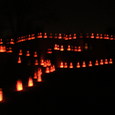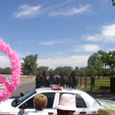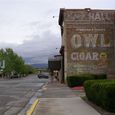« The Only Cartoon to be Nominated for the Nobel Peace Prize | Main | A Tree With a Massive Knife On Top »
Tuesday, December 26, 2006
Break the Silence on Plutonium Pit Production!
From Greg Mello, Los Alamos Study Group:
It’s an eerie moment in U.S. nuclear history. Policy teeters on a knife-edge between disarmament an rearmament, but silence largely reigns. The attention of policy-makers, the public, the nonprofit community, and the foundations that largely fund and direct them has not caught up with events, leaving the real policy decisions chiefly in the hands of autonomous, largely unconscious, nuclear bureaucracies.
The National Nuclear Security Administration (NNSA) hopes to begin producing plutonium warhead cores (“pits”) next year at Los Alamos. If that happens, it will be the first time the U.S. has produced pits in 18 years. With new pits, the production of new warheads can also restart, lighting up all ten warhead factories, labs, and NNSA administrative centers with new work and a fresh sense of importance.
Of course these events will echo around the world, reinforcing those who say their nation too should have nuclear weapons. Security will decline for everyone.
Without new pits and the new production that goes with them, the warhead enterprise faces serious internal crises related to an aging workforce, declining practical skills, poor morale, and a fading ideological commitment to nuclear weapons, among other problems. The apparent social consensus that once supported U.S. WMD in the face of bedrock moral values and sound safety, fiscal, and environmental practices has long evaporated.
For at least the next 16 years only Los Alamos can make pits. Yet despite the expenditure of $2.5 billion (B) here so far on pit production numerous problems remain, including serious safety and infrastructure deficiencies. To review some of these problems, look under “LANL” at the Defense Nuclear Facilities Safety Board (DNFSB) web site, www.dnfsb.gov.
The DNFSB has no enforcement powers and relies on NNSA’s voluntary compliance, Congress, and knowledgeable public outcry to keep LANL and other sites safe. Unfortunately NNSA is in the process of implementing a contractor “self-monitoring” system at LANL which is virtually guaranteed, in our view, to produce accidents. One of NNSA’s stated goals is to overcome what it perceives as a “risk-averse” culture in order to “get the job done.”
The situation is grotesque. The U.S. has almost 10,000 nuclear warheads and bombs. Thousands are backups, part of a multi-tiered redundancy that puts the “assured” in “mutual assured destruction.” This is too many even for Mr. Bush, who wants to drop the arsenal to 6,000 by 2012.
Behind the backups and the backups’ backups are extra pits, 13,000 or so of them stored at the Pantex warhead assembly plant near Amarillo.
Pits last a long time. Results of long-awaited accelerated aging studies show that all the pits in the U.S. arsenal have at least six decades of “service” left.
So why make them? Aside from the need to create “end-to-end” work so the enterprise can feed and sustain itself, the other reason for pit production is that even a small production line allows the prompt (“responsive”) production of “boutique” warheads that might be needed for special occasions.
This is not solely a Bush Administration idea. In 1999, when Bill Richardson was Secretary of Energy, LANL gave Congress a detailed briefing on the idea.
As pit production moves toward startup, some $2 B in new LANL plutonium-related facilities is also in the works. The flagship project is a $1 B pit production annex called the “Chemistry and Metallurgy Research Replacement” facility, but several other projects are also involved. NNSA hopes these projects will increase LANL’s pit production capacity enough to build large numbers of new warheads over a multi-decade period, including “small builds of special weapons.”
The CMRR, widely understood to commit NNSA to pit production at LANL indefinitely, is controversial in Congress. The Republican-led House Appropriations Committee wants to kill the project, calling it “irrational” and “stupid.” Republican Pete Domenici promotes it.
What’s eerie is the silence from the arms control community, the Democrats, and the public. Testimony at “Complex 2030” scoping hearings, however heartfelt, is irrelevant to policy decisions – and doubly irrelevant as regards pit production at LANL.
Some arms controllers and Democrats actually want pit production at LANL; others simply don’t know what’s going on. Public debate is led away from these sensitive subjects by powerful foundations, by peer pressure within the nonprofit community, and by career concerns. Most churches fear losing members and contributions.
Practically speaking, the New Mexico congressional delegation holds veto power, should they choose to use it, over pit production at LANL and the new “CMRR” pit factory. They need to hear from us in clear, specific terms: stop pit production before it starts, and cut funding for the CMRR.
[This commentary was written as a guest editorial for a local newspaper.]
Editor's Note: Visit Congress.org for an easy way to contact our congressional delegation.
December 26, 2006 at 09:54 AM in Nuclear Arms, Power | Permalink









